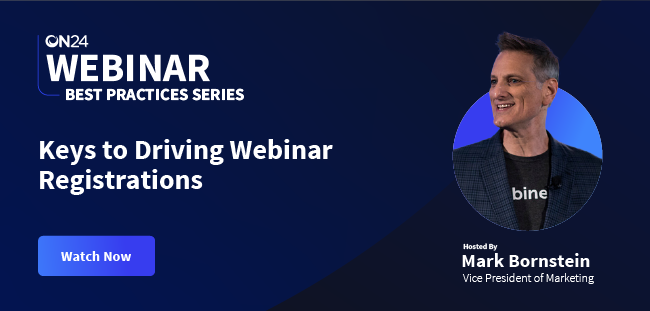Generating inbound leads is a fundamental goal of any B2B business. Inbound marketing — the practice of attracting visitors to your website to nurture them into leads — increases your pool of customers and yields an attractive ROI. When stacked against paid ads, stats show inbound marketing generates triple the leads for every dollar spent.
Inbound lead gen touches nearly every aspect of modern digital marketing. Brand marketing, social media, virtual events, webinars — each are an element that can contribute to inbound marketing and help organizations meet their goals.
The takeaway? And how to drive inbound leads? If you’re not practicing inbound marketing, it’s time to start.
But how do you begin? What strategies are most effective and where should you focus to attract as many leads as possible?
Read on to discover how to generate inbound leads with five highly effective inbound marketing strategies.
1. Optimize Your Content Strategy for Effective Inbound Lead Generation

Identifying this content is a matter of regularly reviewing content performance. Often, this can be done through tools like Google Analytics, SEMrush and others.
But not all content holds the same value. A static webpage, like a blog, can only tell how long a person visited, how much they read and if they went anywhere on your website after hitting your landing page.
Engaging content, like content hubs and webinars, can tell you what visitors are actively engaging with, what they’re looking for and provide them the opportunity to talk directly with you. For example, content hubs — like those powered by ON24 Engagement Hub — can provide insights into the popular content types and topics that generate the most engagement.
Webinars can take engagement insights even further. Attendees can talk directly to sales representatives via chat, download resources and participate in polls and surveys during the event. Webinar producers can also see how long visitors attend an event and how often they engage with the content and messaging.
With this information in hand, marketers can use these insights to optimize their content strategy around topics and formats that drive measurable results. For some additional reading on content marketing and how you may optimize your own strategy, refer to our all-encompassing content marketing guide.
See engagement data in action. Check out how you can achieve more with ON24.
2. Host Webinars to Attract Inbound Leads

Blogging is one of the most widely used content types for attracting inbound leads. However, if you want to broaden your reach and enhance your inbound lead generation efforts, you should consider webinar hosting.
Hosting informative webinars is a cost-effective way to establish yourself as an industry expert and can help you reach a broader audience.
Webinars can help you capture, nurture and convert leads effectively – in fact, data shows that 20-40% of webinar attendees enter the sales pipeline as qualified leads.
An interesting topic will attract audiences with a knowledgeable host or panel. But more importantly, this virtual event can allow your team to engage directly with participants for upwards of an hour.
Think about that for a moment: in an hour, you can capture audience attention, directly learn their pain points — whether through chat, polling, or Q&A — provide meaningful, relevant content and measure their overall interest in your solution with engagement data.
Your marketing and sales teams can easily take action with this engagement data in hand. Marketing can easily segment and nurture based on activity. Sales can seamlessly continue the conversation based on an attendee’s participation.
The options are limitless.
3. Launch Engaging Social Media Campaigns

Another powerful way to generate inbound leads is through social media marketing. It’s an effective channel for building brand recognition, establishing trust, and attracting meaningful relationships. Perhaps that’s why 89% of B2B marketers use LinkedIn for B2B lead generation.
However, to effectively gain inbound leads from social media marketing, you must plan ahead. Simply sharing blog posts and events on social media is not enough.
Instead, social media strategy should be based on engagement and sharing your brand’s positioning on given topics. This means having your subject matter experts participate in conversations and encouraging employees to share more about your company’s culture and values.
This often means keeping a bead on industry trends and personalities for inbound marketers. With a firm grasp of industry changes, you can identify the content you want to share, set up a content calendar, and schedule your social posts.
It’s essential to monitor the results of your social media efforts, whether they be employee advocacy, multi-media or a drive behind a particular campaign.
Another thing to remember is that not all social platforms are the same. Effective inbound marketing lead generation requires tailoring your content accordingly. Every platform attracts different types of users looking for a different content experience, which you should carefully consider.
For instance, the audience’s expectations of TikTok videos differ significantly from those of YouTube. Likewise, audiences on Facebook have very different expectations of how they’ll interact with a business than they would on LinkedIn.
However, you don’t need to create different content for every platform. Consider repurposing existing content for use across various channels.
For example, you could break up a long-form seminar or a how-to video created for YouTube into multiple bite-sized content experiences for platforms like TikTok or Instagram.
If you’re keen to accelerate your lead generation strategy and think about getting inbound leads quickly, social media is one of the fastest ways to see improvements.
4. Enhance SEO Strategies to Boost Inbound Marketing Leads

If you want to generate inbound leads, you’ll also need to devote a lot of time to implementing strong search engine optimization. SEO (search engine optimization) is the practice of optimizing your website and content so it will rank higher on search engines like Google and Bing.
SEO is essential for inbound marketing and with a 14.6% lead close rate, can drive some serious ROI. Without good SEO in place, you may lose out on opportunities to connect with audiences interested in what you offer.
Some of the fundamental SEO practices include:
-
- Optimizing website loading speed
- Keyword research
- Incorporating relevant keywords into your pages and content
- Making it easier for search engines to read and understand your website
- Optimizing images for accessibility and loading speed
- Attracting links from other websites
Incorporate Google’s E.E.A.T Principles
Google is the standard search engine for audiences. So, what kind of content performs well on Google?
Generally, the search engine prioritizes content meeting the EEAT (shorthand for Experience, Expertise, Authoritativeness and Trustworthiness) principle. Google’s aim is to ensure that its users can rely on the content they click on being trustworthy. To do this, Google encourages publishers to follow its EEAT guidelines.
This often means publishing in-depth, long-form content that is engaging, clear and informative. However, this isn’t the crux of what EEAT is about. It all comes down to the following:
Demonstrating Experience: Demonstrating experience of the subject matter could be achieved through sharing first-hand accounts, including relevant experience in author bios, or incorporating reviews from real-life customers.
Showcasing Expertise: It’s important that the content creator has relevant credentials that make them qualified to talk about the topic. Adding expert sources for any claims you make can also help showcase expertise.
Building Authoritativeness: Earning backlinks from other sites is one of the most important ways to show that you’re a recognized authority on the subject. Authority can also be built by increasing the amount of content you’ve published around a specific subject.
Establishing Trustworthiness: Trust can be established by keeping content accurate and up-to-date, publishing easy-to-access contact details and data usage policies, and showcasing trust signals such as industry publications you’ve appeared in.
Google wants to provide its users with the most relevant and reliable information, meaning comprehensive, high-quality content that adheres to EEAT principles is more likely to get you inbound leads over time. Another benefit of creating high-quality content is that more people are likely to link to it, which is highly advantageous from an SEO perspective.
5. Fine-Tune Your Website Design To Encourage Conversions

Getting someone to your website is one thing, but you need to ensure your site and its content are easy to understand and navigate. 42% of people will leave a website because of poor functionality, with potential leads ending up looking for better solutions elsewhere.
To avoid this, work with your web development team or agency to optimize your site’s layout, navigability and readability for both search engines and humans.
There are many ways you can drive traffic to your website and turn that traffic into inbound marketing leads. If you’re unsure where to start optimizing your website, ask yourself a few questions. These can be:
-
- Can visitors easily navigate the site?
- Is your contact page easily accessible?
- Can your visitors easily navigate to product/solution pages accessible from every page on the website?
- Is your content easy to read?
If not, devote some time and resources to revamping elements of your website. A best practice is to implement an A/B testing regime to find what works best for your audience.
6. Implement Lead Scoring to Prioritize Prospects

Generating inbound leads is one thing, but knowing which leads to prioritize is key to optimizing your sales and marketing efforts. Lead scoring assigns a value to each prospect based on their behavior and engagement level, helping teams focus on high-priority leads.
Identifying priority leads requires data. Use tools to track engagement across key interactions—such as webinar attendance, content downloads, and time spent on your website—to assign a score to each lead. Integrate your scoring system with your CRM to automate the process and ensure both marketing and sales are aligned on follow-up priorities.
With ON24’s engagement scoring, you can easily identify high-value prospects, focus on those with buying potential, and increase conversion rates.
7. Offer Personalized Web Experiences

Inbound leads are more likely to convert when they receive content tailored to their preferences. Personalization is a crucial strategy for creating engaging experiences that resonate with your audience.
To offer personalized web experiences, use dynamic landing pages that adapt based on visitor interactions, such as previously viewed content or stage in the buyer’s journey. You can also include personalized content recommendations and CTAs to keep visitors engaged and guide them toward conversion.
With ON24’s real-time engagement tools, you can create dynamic, personalized experiences for inbound prospects, ensuring they encounter the right message at the right time.
8. Run Account-Based Marketing (ABM) Campaigns

Account-Based Marketing (ABM) is a highly targeted approach that focuses on key accounts most likely to generate revenue. By concentrating on high-value prospects, ABM ensures that your efforts are focused on leads with the highest ROI potential.
Begin by working with your sales team to identify target accounts. Then, create personalized campaigns and exclusive events—like targeted webinars—that cater directly to the needs and challenges of those accounts. The goal is to offer a tailored experience that drives deeper engagement and accelerates the sales cycle.
With ON24’s platform, you can host personalized events and use real-time engagement data to strengthen your ABM strategy.
9. Use Third-Party Content Syndication

If your goal is to expand your reach and attract new inbound leads, third-party content syndication can be a valuable strategy. Content syndication involves distributing your high-value content—such as reports, e-books, or whitepapers—across trusted platforms with relevant audiences.
When using content syndication, ensure you’re offering gated assets that require prospects to provide their contact information. Once leads are captured, follow up promptly to nurture them into the next stage of the funnel.
ON24’s platform makes it easy to track lead engagement, helping you integrate syndicated leads into your marketing pipeline seamlessly.
10. Offer Exclusive, Gated Content

Gated content remains one of the most effective methods for generating high-quality inbound leads. By offering exclusive resources—such as industry reports, templates, or guides—in exchange for contact information, you can quickly grow your lead list.
To succeed with gated content, ensure the value of the resource justifies the exchange. Keep forms short to minimize friction, and consider A/B testing different versions of your landing page to optimize conversion rates.
With ON24’s capabilities, you can create and promote gated content while capturing real-time engagement data to improve your lead generation efforts.
11. Use Conversational Forms to Streamline Lead Capture

Traditional forms are static, but conversational forms offer a more interactive and user-friendly experience. Instead of asking prospects to fill out a long form, conversational forms guide users through a series of dynamic, personalized questions—making the process feel more natural and engaging.
Why conversational forms work:
-
- They reduce friction by asking one question at a time, improving completion rates.
- They can be tailored in real-time based on a prospect’s responses, ensuring relevancy.
- They create a more engaging experience, which can increase the likelihood of conversion.
Consider embedding conversational forms on high-traffic landing pages and integrating them with your CRM to automate lead capture and follow-up. This approach not only captures more leads but also improves the overall user experience.
Tools and Resources to Boost Inbound Lead Generation

While strategies provide the framework for generating inbound leads, having the right tools and resources can make the execution process faster, smarter, and more efficient. Below are some key tools that can support each strategy, helping marketers attract, engage, and convert leads more effectively:
Content Strategy Tools
Creating and optimizing content is at the heart of inbound marketing. These tools help ensure that your content is engaging, targeted, and measurable.
- SEMrush – A powerful SEO tool that aids in keyword research, competitive analysis, and content optimization to improve search rankings and drive traffic.
- Google Analytics – Essential for tracking content performance and understanding visitor behavior, helping marketers refine their strategy based on real-time insights.
- The ON24 Platform’s content hub capability – An all-in-one content hub solution that allows marketers to centralize their content, track engagement, and generate leads from a single platform.
Webinar and Virtual Event Platforms
Hosting webinars and virtual events is one of the most effective ways to attract inbound leads. These tools streamline event creation and maximize engagement:
-
- The ON24 Platform’s webinar capability – Purpose-built for creating professional, interactive webinars that generate actionable engagement data, helping marketers capture and nurture high-quality leads.
Social Media and Campaign Management Tools
Social media is a key driver for inbound leads. These tools help manage and analyze social campaigns:
-
- Hootsuite – A social media management tool that allows scheduling, monitoring, and reporting across multiple platforms.
- LinkedIn Campaign Manager – Designed specifically for B2B marketers, this tool helps create targeted ad campaigns and track engagement.
- Sprout Social – A platform that offers advanced social listening, engagement, and analytics capabilities.
SEO and Website Optimization Tools
Optimizing your website and content for search engines is crucial for driving organic traffic. Use these tools to stay ahead in SEO:
-
- Yoast SEO – A WordPress plugin that makes on-page SEO easy by providing real-time feedback on keyword usage, meta descriptions, and readability.
- Moz Pro – A comprehensive SEO toolset for keyword research, rank tracking, and site audits.
- Crazy Egg – A heat mapping tool that helps visualize how users interact with your website, enabling better optimization for conversions.
Lead Scoring and Personalization Tools
Prioritizing leads and delivering personalized experiences is critical to improving conversion rates. These tools help automate and refine that process:
-
- ON24 Performance Analytics – Provides real-time engagement data and lead scoring from webinars, content hubs, and virtual events, helping sales teams focus on high-priority leads.
- HubSpot CRM – An integrated platform that offers lead scoring, marketing automation, and advanced personalization capabilities.
- Marketo Engage – A robust marketing automation tool for delivering personalized campaigns at scale.
Content Syndication and Gated Content Tools
Content syndication and gated content help expand reach and capture leads. These tools make the process seamless:
-
- Outbrain – A platform for promoting your content on high-traffic websites, increasing exposure and driving inbound leads.
- ON24 Personalized Landing Pages – Helps create personalized, gated content experiences that can capture leads while delivering tailored value to prospects.
- Leadfeeder – A tool that identifies companies visiting your website, providing actionable insights for your sales team.
Conversational Forms and Chatbots
Interactive, real-time engagement tools like conversational forms and chatbots are excellent for improving lead capture rates:
Additional Strategies and Emerging Trends for Inbound Lead Generation

Inbound lead gen strategies progress as quickly as the tools and platforms that facilitate them. If you’re wondering how to increase inbound leads in 2025, here are some key emerging trends to explore:
-
- AI lead nurturing: AI-powered tools and chatbots can engage with audiences directly, providing answers to questions, offering personalized content recommendations, and sending automated follow-up emails. This allows for 24/7 lead nurturing and a better experience for potential inbound leads.
- Intent targeting: Inbound lead gen is becoming more advanced with the rise of intent-based marketing. By focusing on intent signals, you can create content and campaigns that match your target audience’s interests and needs, attracting highly relevant leads inbound to your sales pipeline.
- Interactive experiences: Interactive experiences are naturally more engaging as they involve some degree of participation. Utilizing interactive features in your webinars and blog posts (e.g. Q&A sessions or online calculators) offers more value to your audience, gives you points to follow-up on, and creates a more memorable experience.
Lead Nurturing and Conversions
Generating inbound leads is only the first step; nurturing those leads into loyal customers is where true value lies. Lead nurturing involves understanding your prospects’ needs and delivering personalized, timely experiences that guide them through the buyer’s journey. Effective nurturing builds trust, increases engagement, and boosts conversion rates.
Start by segmenting your audience based on behavior and engagement data. Tools like ON24 Intelligence can help you prioritize high-value prospects and tailor communications to match their journey stage. In the awareness phase, educational content sparks interest. For leads in the consideration stage, detailed webinars or case studies address specific needs. When prospects are ready to decide, personalized demos and free trials provide the final push.
Engagement bridges the gap between nurturing and conversion. Interactive elements like live Q&A or polls during webinars keep prospects involved, while timely follow-ups—within 24 hours—help maintain momentum. Simplifying the conversion process with clear CTAs, pre-filled forms, and customer testimonials can further reduce friction and build confidence.
By focusing on personalization, engagement, and seamless conversions, you create a lead nurturing strategy that turns prospects into long-term advocates. Curious about how ON24’s tools can streamline this process?


